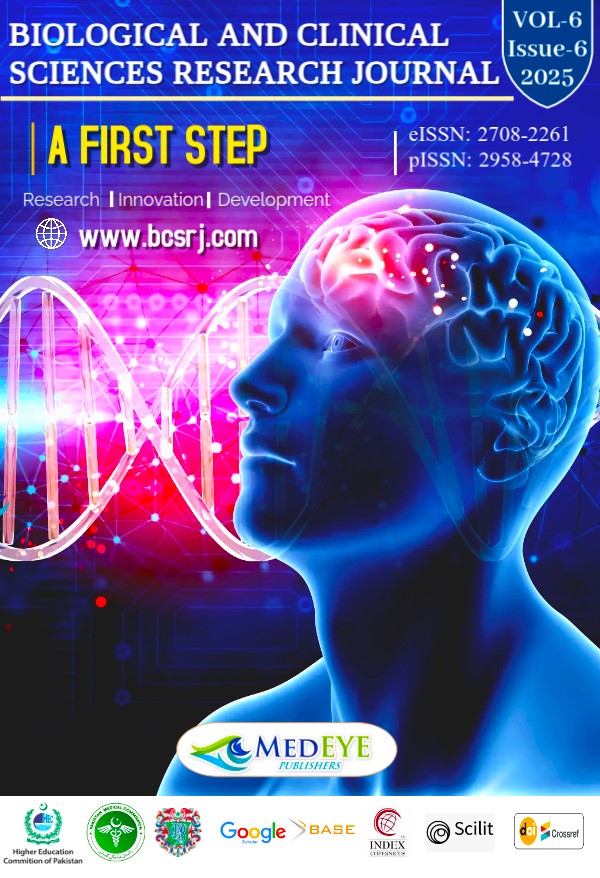Avoiding Cleavage of the Sternum: A Better Approach in Patients with Myasthenia Gravis
DOI:
https://doi.org/10.54112/bcsrj.v6i6.1795Keywords:
Myasthenia Gravis, Thymectomy, VATS, Sternotomy, Thymoma, WHO Classification, Masaoka Staging, Surgical OutcomesAbstract
Thymectomy is a well-established treatment for Myasthenia Gravis (MG), but the optimal surgical approach—median sternotomy versus Video-Assisted Thoracoscopic Surgery (VATS)—remains under debate. This study evaluates the outcomes of these approaches to determine the effectiveness and safety of avoiding midline sternotomy. Objective: To assess the clinical, pathological, and postoperative outcomes of thymectomy using VATS compared to median sternotomy in MG patients. Methods: A retrospective analysis was conducted on 173 MG patients who underwent thymectomy from July 2002 to June 2024 at a tertiary care center. Data on demographics, histopathology, surgical approach, WHO thymoma classification, Masaoka staging, and clinical outcomes were collected and analyzed. Preoperative optimization included 3–5 cycles of plasmapheresis. Results: Of the 173 patients, 108 underwent VATS thymectomy and 65 underwent sternotomy. Thymic hyperplasia was the most common histological finding. Thymomas were more prevalent in males and were primarily Type B2 under the WHO 2015 classification. Most thymomas were Stage I or II per Modified Masaoka staging. Complete remission was achieved in 30.1% of patients, palliation in 28.3%, no clinical change in 30.6%, while 2.9% succumbed to disease complications. VATS thymectomy was associated with reduced morbidity and better postoperative recovery. Conclusion: VATS thymectomy is a safe and effective surgical option for MG, offering improved clinical outcomes and reduced need for postoperative analgesia and ICU stay. Avoiding midline sternotomy enhances patient recovery and reduces complications, especially in resource-limited settings.
Downloads
References
Carr AS, Cardwell CR, McCarron PO, McConville J. A systematic review of population based epidemiological studies in Myasthenia Gravis. BMC neurology. 2010;10:1-9.
ABBAS Z, ABBASI A, ABBASI N, QAYYUM A, ABEYSEKERA W, AFSHAN F, et al. ABBAS K. Journal of the College of Physicians and Surgeons Pakistan. 2013;23(12):924-33.
Drachman DB. Myasthenia gravis and other diseases of the neuromuscular junction. HARRISONS PRINCIPLES OF INTERNAL MEDICINE. 1998:2469-72.
Wolfe GI, Kaminski HJ, Aban IB, Minisman G, Kuo H-C, Marx A, et al. Randomized trial of thymectomy in myasthenia gravis. New England Journal of Medicine. 2016;375(6):511-22.
Rueckert J, Swierzy M, Badakhshi H, Meisel A, Ismail M. Robotic-assisted thymectomy: surgical procedure and results. The Thoracic and cardiovascular surgeon. 2015;63(03):194-200.
Qi K, Wang B, Wang B, Zhang L-B, Chu X-Y. Video-assisted thoracoscopic surgery thymectomy versus open thymectomy in patients with myasthenia gravis: a meta-analysis. Acta Chirurgica Belgica. 2016;116(5):282-8.
Aramini B, Fan J. Technique for myasthenia gravis: subxiphoid approach. Thoracic surgery clinics. 2019;29(2):195-202.
Wolfe GI, Kaminski HJ, Aban IB, Minisman G, Kuo H-C, Marx A, et al. Long-term effect of thymectomy plus prednisone versus prednisone alone in patients with non-thymomatous myasthenia gravis: 2-year extension of the MGTX randomised trial. The Lancet Neurology. 2019;18(3):259-68.
Wu W-J, Zhang F-Y, Xiao Q, Li X-K. Does robotic-assisted thymectomy have advantages over video-assisted thymectomy in short-term outcomes? A systematic view and meta-analysis. Interactive Cardiovascular and Thoracic Surgery. 2021;33(3):385-94.
Iacomino N, Tarasco MC, Berni A, Ronchi J, Mantegazza R, Cavalcante P, et al. Non-Coding RNAs in Myasthenia Gravis: From Immune Regulation to Personalized Medicine. Cells. 2024;13(18):1550.
Huang EJ-C, Wu M-H, Wang T-J, Huang T-J, Li Y-R, Lee C-Y. Myasthenia gravis: novel findings and perspectives on traditional to regenerative therapeutic interventions. Aging and disease. 2023;14(4):1070.
Marx A, Chan JK, Coindre J-M, Detterbeck F, Girard N, Harris NL, et al. The 2015 World Health Organization classification of tumors of the thymus: continuity and changes. Journal of Thoracic Oncology. 2015;10(10):1383-95.
Lee Y, Samarasinghe Y, Patel J, Khondker A, McKechnie T, Samarasinghe N, et al. The short and long-term effects of open vs minimally invasive thymectomy in myasthenia gravis patients: a systematic review and meta-analysis. Surgical Endoscopy. 2023;37(5):3321-39.
Suster S, Moran CA. Thymoma classification: current status and future trends. American journal of clinical pathology. 2006;125(4):542-54.
Aydın Ö. Gebelikte Maternal Sistemik Hastalıklar: Akademisyen Kitabevi; 2022.
Downloads
Published
How to Cite
Issue
Section
License
Copyright (c) 2025 Muhammad Kaleem Ullah, Muhammad Sami Ullah, Muhammad Rashid, Mansoor Ali, Ayesha Tariq

This work is licensed under a Creative Commons Attribution-NonCommercial 4.0 International License.








